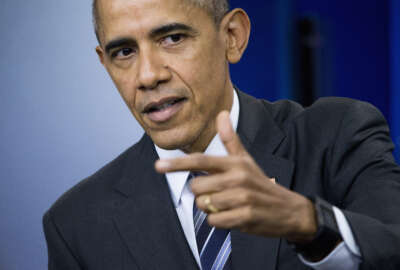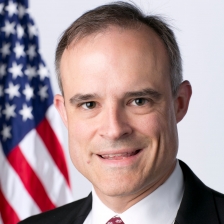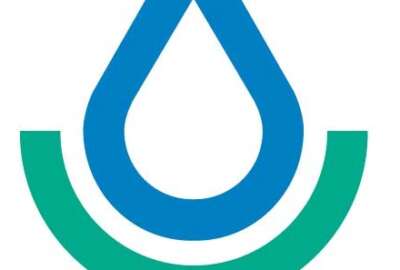
As IT budget request inches up, OMB underscores better overall management
President Barack Obama is requesting $89.8 billion for federal IT in 2017, including $51.3 billion for civilian agencies and $38.5 billion for the Defense...
The federal information technology budget would increase by more than $1.1 billion in 2017 under President Barack Obama’s proposed budget.
But the $89.8 billion request is really just the icing on a budget cake filled with all sorts of goodies for agencies and contractor alike.
The President is asking Congress in his 2017 budget request sent to Capitol Hill on Feb. 9 to increase both civilian agency ($51.3 billion) and Defense Department ($38.5 billion) IT spending by about $600 million each, which would continue the slow-growing trend of 1.8 percent since 2009.
The Office of Management and Budget has not yet released the agency-by-agency breakdown for IT spending, but it should be available in the coming days or weeks.
The increased IT spending request pales in comparison to the administration’s plans for cybersecurity. President Obama is requesting $19 billion for 2017, a 35 percent increase over 2016 spending enacted by Congress.
The cybersecurity funding request is to support both short and long-term initiatives, such as a new federal chief information security officer (CISO) in OMB, several workforce recruitment and training initiatives, and a new broad-reaching Cybersecurity National Action Plan (CNAP).
OMB also requested $10 million for its cyberstat and other oversight efforts, which is equal to what it asked for in 2016.
The budget request also highlights the intersection of cybersecurity and IT through the new IT Modernization Fund. The President is requesting $3.1 billion to create a revolving fund for agencies to have seed money to modernize old IT systems, in part because of the cybersecurity risks that come with using legacy technology. The General Services Administration will run the modernization fund.
“Today I met with the President and other senior administration officials at the White House to discuss the importance of executing the Cybersecurity National Action Plan and GSA’s role in moving our government into the 21st century,” said Denise Turner Roth, GSA’s administrator in a press call with reporters on Feb. 9. The replacement of legacy IT systems that this fund will “allow is a major portion of our ability to meet the goals of this initiative.”
Turner Roth said the CNAP gives GSA several new jobs, including standing up a service to let citizens interact with the government in a new, more secure way, and create new contract vehicles for agencies to enhance cybersecurity.
IT acquisition, cybersecurity, agile development
The IT policy section offers more details about the IT Modernization Fund, including the creation of a project review board made up of IT acquisition, cybersecurity and agile development experts.
The board “will review agency business cases and select projects for funding to ensure prioritization of projects with the highest risk profile, governmentwide impact and probability of success,” the budget stated. “The board will identify opportunities to replace multiple legacy systems with a smaller number of common platforms — something that is difficult for agencies to do when acting on their own with limited insight into other agencies’ operations.”
Additionally, OMB plans to create a team of systems architects and developers to provide additional oversight and development capabilities.

OMB’s push for modernization is directly related to cybersecurity as it lists outdated technology and fragmented governance as two of the biggest challenges agencies face.
“We have connected very deeply in this budget both the modernization of our IT along with our modernization of our approach to how we handle cybersecurity,” said Michael Daniel, the special assistant to the President and cybersecurity coordinator in the White House. “The CNAP goes hand-in-hand with what the administration is trying to do with its approach to IT and technology globally. In particular, we believe it’s critically important that we begin to address the underlying structure weaknesses that we have in federal cybersecurity by modernizing our underlying IT, by updating the governance structure that we have so agencies can actually manage their cybersecurity more effectively by accessing much more common and shared services across the government, and investing in our people so we have the adequate resources concentrated in the right places so agencies can effectively carry out their cybersecurity mission.”
Civilian agencies continue to spend almost three-quarters of their IT budget on legacy systems. OMB says about $36 billion out of $51 billion IT budgets for non-DoD agencies are spent on operations and maintenance (O&M).
The White House didn’t include any data on the Defense Department’s spending on O&M, but deputy federal chief information officer Lisa Schlosser said recently that the breakdown across the government is about 76 percent on O&M and 24 percent on new or modernized IT systems.
“Improving federal cybersecurity will require an accelerated push to strengthen the government’s highest value IT and information assets and to retire, replace or upgrade hard-to-defend legacy IT,” the document stated. “This will require not just modernizing hardware and software, but also improving how we manage the lifecycle of IT investments so that security gains can be sustained over time. This approach will improve the government’s risk management capability, improve the cyber-defense landscape and enhance our ability to respond to changing threats.”
Similarly, OMB requested $35.2 million for the IT Oversight and Reform (ITOR) fund to help address modernization challenges.
“ITOR funding will be used to enhance transparency, data collection, analytics and technical assistance in federal IT investments. ITOR oversight activities will support continued operations of and enhancements to the federal IT Dashboard, improving the public’s view of the Government’s annual investment in IT,” the budget stated. “Building on data from the IT Dashboard and an integrated agency data collection process, the Federal CIO will continue to engage with agencies through PortfolioStat reviews, identifying underperforming and duplicative investments and taking corrective actions. Additionally, ITOR funds will support policy analysis and development efforts to support Federal IT reform, including continuing to support governmentwide implementation of the Federal Information Technology Acquisition Reform Act (FITARA). ITOR oversight activities will increase the productivity of IT investments by, for example, optimizing and consolidating data centers under the Federal Data Center Consolidation Initiative, continuing the adoption of cloud computing, and increasing the use of intra-agency and interagency shared services.”
A high-caliber IT workforce
But even if Congress doesn’t support the new modernization fund, OMB says agencies are making real progress in improving federal IT.
OMB says 77 percent of all rated investments are “green,” up from 69 percent in 2012 on the IT Dashboard.
Agency improvements in meeting project goals is, in part, because of their increased use of agile development. OMB says agencies are delivering value in projects 23 days faster than they were in May 2013. This, however, is down from 21 days in 2016. OMB says agile development projects are 33 percent more likely to deliver planned capabilities on budget than using the “waterfall” approach.
Agencies also are spending more money on cloud computing and other provisioned services. OMB says about 8.2 percent of the IT budget goes toward these types of services as compared to 8.5 percent in 2016.
Part of the move to modern and agile IT development processes is the need to improve the federal workforce. OMB addresses this need in several ways. The administration says the budget request continues to support the recruitment of employees with these skillsets for two-year assignments under Schedule A hiring authority.
“Having a high-caliber IT workforce is key to lasting success in each of the administration’s technology initiatives,” the budget stated. “For example, the administration has set an aggressive goal of hiring and placing 500 top technology and design experts to serve in the U.S. government by January 2017 to dramatically improve customer satisfaction with federal technology services.”
Federal CIO Tony Scott said OMB plans to scale the use of digital services up to 25 agencies and grow the total workforce to almost 500 people. He said digital services will continue to play a bigger role going forward.
To that end, OMB requested $18 million for the U.S. Digital Services Office, up from $14 million in 2016.
GSA also is requesting $7 million for its digital services office run by the Office of Citizen Services and Innovative Technologies (OCSIT), down from $8 million in 2016. The agency also wants $15 million for the E-Government Fund, down from $16 million this year.
OMB says the first class of 30 contracting officers enrolled in a new training class to buy digital services in October.
OMB also reported agencies have closed more than 3,179 data centers, led by GSA’s decision to consolidate 71 percent of its total. The data center consolidation effort is part of how OMB says agencies have saved $3.5 billion to $4 billion since 2012. The administration says other oversight programs such as PortfolioStat, commodity IT consolidation efforts under Category Management and shared services also contributed to that total.
Copyright © 2025 Federal News Network. All rights reserved. This website is not intended for users located within the European Economic Area.
Jason Miller is executive editor of Federal News Network and directs news coverage on the people, policy and programs of the federal government.
Follow @jmillerWFED




